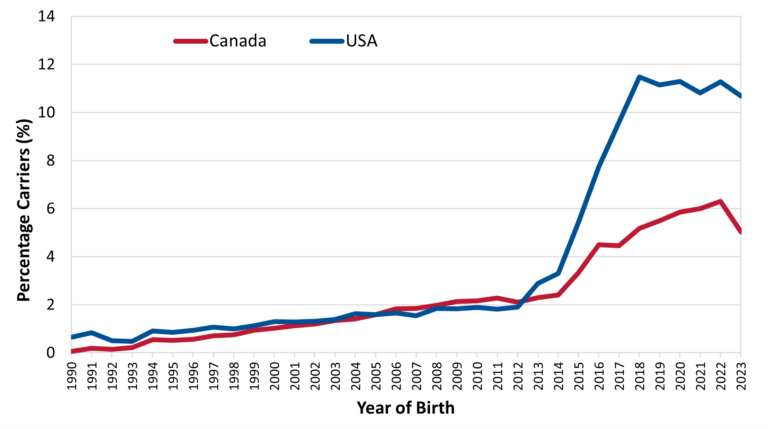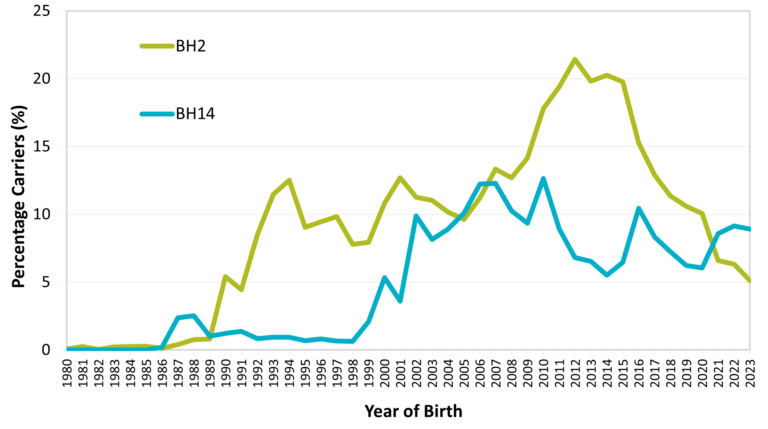
Source: Lactanet
by: Hannah Sweett, Ph. D. and Allison Fleming, Ph. D.
The dairy industry has reaped substantial benefits from genomics, including advancements ranging from rapid genetic improvements for essentially all traits to the identification and management of undesirable genetic conditions and haplotypes. The latest discovery of these includes the Early Onset Muscle Weakness Syndrome affecting the Holstein breed and the Brown Swiss Fertility Haplotype BH14. Effective April 2024, Lactanet publishes Muscle Weakness (MW) gene test results as well as Carrier Probability values for the Muscle Weakness Haplotype (HMW) and BH14.
What is Early Onset Muscle Weakness?
Early Onset Muscle Weakness Syndrome (MW) is characterized by calves that are unable to stand at birth or lose the ability to stand shortly after birth. The condition presents itself with varying degrees of severity with some affected calves able to recover. Most affected calves, however, do not survive past 6 weeks of age. The earliest known carrier of this genetic condition is Southwind Bell of Bar-Lee, born in 1984. His descendants, Roylane Socra Robust-ET, born in 2008, and Seagull-Bay Supersire, born in 2010, were key contributors to the spread of the MW gene throughout the Holstein breed.
Gene Test for Muscle Weakness
Researchers at Pennsylvania State University conducted several analyses on affected and unaffected calves to determine the genetic origin of the Muscle Weakness condition and identified a mutation in the CACNA1S gene on chromosome 16 that was common among affected calves. This gene is known to make calcium channels in skeletal muscle and mutations in such channels were reported to lead to muscle paralysis in humans. The condition is recessive in nature, meaning only calves that have inherited the undesirable gene from both parents will be affected. However, it is not as simple as this. Incomplete penetrance is displayed, so a very small number of animals with two copies for the negative gene can survive into adulthood.
Using this information, a gene test was developed and is widely used by AI companies to identify bulls that are carriers or free of the undesired gene. Approximately 14,000 gene test results have been shared with Lactanet, which are now displayed on our website alongside other genetic condition codes. The same gene test results have also been shared with Holstein Canada. Muscle Weakness gene test results are displayed using the following codes:
- MWF = tested non-carrier (free)
- MWC = tested carrier (heterozygous, 1 copy)
- MWS = tested true carrier (homozygous, 2 copies)
Carrier Probability Values
For those animals that do not have a gene test result, a haplotype result can be used to identify the carrier status of genotyped animals in the Holstein breed. In conjunction with the December 2023 genetic evaluation release in United States, the Council on Dairy Cattle Breeding (CDCB) introduced and published its internal haplotype results for MW, abbreviated as HMW.
To reflect the likelihood that an animal carries HMW, Lactanet calculates a Carrier Probability value for every animal in its database based on known gene test results, the haplotype results received from CDCB, and pedigree data. As with all carrier probabilities, they are reported as values ranging from 1%, meaning the animal is likely free of the haplotype, to 99% meaning the animal is likely a carrier. For most genotyped animals, values of 1% and 99% will be displayed while values in between (i.e.: 50%, 25%, …) are displayed for animals that are not genotyped or don’t have a haplotype result available, and an asterisk (*) is displayed next to the label at the start of the row. It is also possible for a single (*) or double asterisk (**) to be displayed after the Carrier Probability values for the Haplotype Associated with Cholesterol Deficiency (HCD) and the new HMW. Animals with a single asterisk indicate they may possibly be affected by the undesirable gene while animals with a double asterisk are most likely expected to be affected. The HMW status for all animals can be found on the Lactanet website using the Animal Query tool. Once you have a found the animal of interest you can go to their “Genetic Evaluation Summary” page to find a pop-up box with Carrier Probability values for HMW along with all other known genetic conditions and haplotypes in the breed. Alternatively, navigate to the animal’s “Pedigree” page to access Carrier Probability values for the animal as well as its parents and grandparents.
Analyzing the available data for Muscle Weakness, Lactanet estimated the carrier frequency in the North American Holstein population and discovered differences between females born in Canada compared to United States (Figure 1). The average estimated HMW carrier frequency in the US Holstein population has steadily increased since 2012, surpassing 11% for females born in 2018, and remaining quite steady in recent years. In contrast, the estimated average HMW carrier frequency in the Canadian Holstein population peaked at roughly 6% for females born in 2022. The main reason for this difference is the fact that semen of Roylane Socra Robust-ET did not qualify for importation into Canada whereas he was widely used in the United States.
Figure 1: Estimated Average HMW Carrier Frequency in North American Holstein Female

Brown Swiss Fertility Haplotype BH14
Like HMW, Carrier Probability values are also now published for the BH14 haplotype in the Brown Swiss breed. First reported in Switzerland in 2022, the BH14 haplotype causes early pregnancy loss and traces back to Ventures Esp Babaray, born in 1978, as the oldest known carrier. In the April 2023 genetic evaluation release in United States, the CDCB began reporting BH14 results which Lactanet now uses to publish Carrier Probabilities. Like other Carrier Probability values, those for BH14 also range from 1% to 99% and indicate the likelihood an animal is a carrier of the undesirable gene. Figure 2 shows the trend in estimated average carrier probability for both Brown Swiss haplotypes, namely BH14 as well as BH2, which causes early embryonic loss or stillbirth. The average carrier frequency for BH14 has fluctuated for the last several years but is almost 9% for Canadian females born in 2023. To date, Brown Swiss breeders have effectively decreased the frequency of BH2 and should apply the same approach to continue reducing this trend along with BH14.
Figure 2: Trend in Percentage Carriers of Haplotypes Affecting Fertility in Canadian Brown Swiss Females

Managing MW and BH14
Now that MW in Holsteins and BH14 in Brown Swiss are known and reported, industry strategies can be used to reduce the occurrence that carrier animals are mated together, effectively lowering the frequency of the causative undesirable genes in their respective breed populations. Lactanet now publishes gene test results for MW and Carrier Probability values for HMW and BH14 to assist in mating decisions. For MW, most Canadian herds have a low carrier frequency, but some herds have up to 40% of their females being a carrier and must diligently look at results. Carrier animals do not directly cause a problem in the population. However, if such carrier females are mated with a carrier bull, then 25% of the resulting pregnancies or offspring will be affected. It is important to closely monitor Carrier Probability values before making mating decisions to effectively reduce the frequency within your herd and the breed.
The Lactanet website is an excellent resource to help manage known undesirable genetic conditions and haplotypes and make better breeding decisions. A pop-up box was recently added to each animal’s Genetic Evaluation Summary, Inbreeding Calculator and Pedigree pages to view their Carrier Probability values for the main genetic conditions and haplotypes. The Inbreeding Calculator also contains new visuals to assist producers in identifying potential matings that have a risk of producing a pregnancy or calf affected by these undesirable genes. Together, the dairy industry can continue to identify and manage undesirable genes, leading to improved herd reproduction, health, and welfare, which translate to increased profitability.






